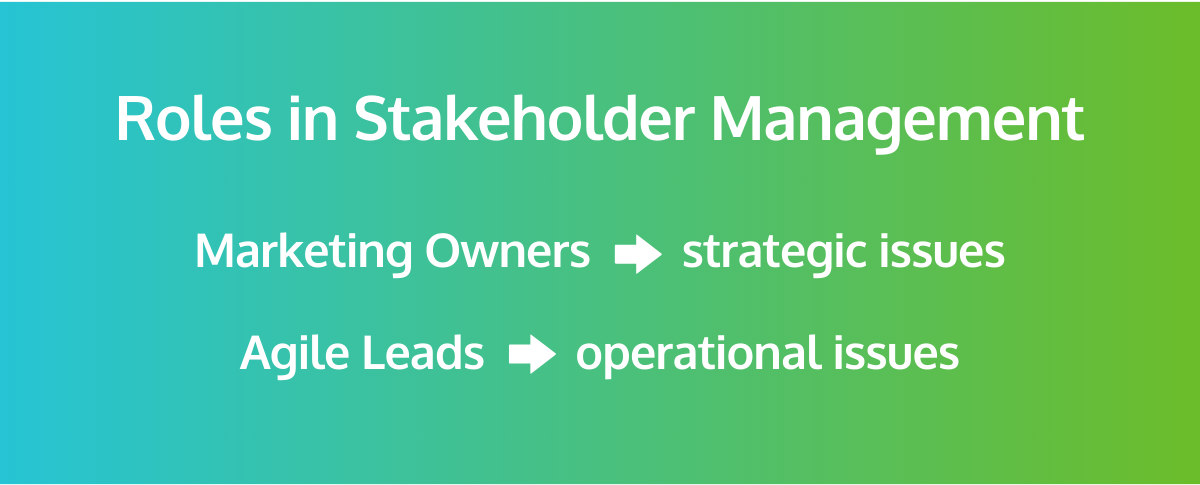Improve your Marketing Ops every week
Subscribe to our blog to get insights sent directly to your inbox.
Confront your process problems head on with a Sherpa by your side.
Explore support options that are tailored to meet you wherever you are on your climb.
Browse our pioneering Agile marketing courses
Learn from the stories of marketers already on the road to process improvement.
Featured Resource

State of Agile Marketing
Learn from 8 years of study on how marketers are increasing their agility.
Download Report
If you’re new to Agile, there’s a good chance you’ve already noticed that we talk about stakeholders a lot. After all, without stakeholders, there’s no clear reason why we do the work we do.
Ignoring them or simply failing to implement proper stakeholder management is how you end up with work that just isn’t fit for purpose.
Consider getting a task like this: a person wants to watch something for entertainment. Without knowing (or caring to know) anything about your stakeholder, do you produce a kids cartoon or a gritty action drama? This is how you end up with products and processes that just don’t work for the people they need to function for.
It’s also perhaps how you end up with a 3 year old watching John Wick, but I digress…

The point is that understanding who your stakeholders are and structuring how you engage with them is not a “nice to have.” It’s foundational for marketing success. Fortunately, our Agile coaches have spent years coaching teams of all sizes on effective stakeholder management, so we’re condensing all that experience and advice here for you.
Let’s start with the basics. A stakeholder is anyone with a stake in your work. That can mean external stakeholders like your customers or internal stakeholders like teams who rely on your work for their own.
For example, for many marketing teams, a major internal stakeholder is sales. The sales team relies on marketing for insights and support and vice versa. Senior leaders are another classic example of an internal stakeholder.
In all of these cases, ignoring stakeholders and stakeholder management is what leads to what are essentially negative externalities. You end up pushing costs to those outside your team, resulting in worse outcomes overall. For example, you might create a process that saves marketing 3 hours of time per week while costing sales 5 hours per week. If you don’t consider your stakeholders, it’s an easy win. If you do, you’ll quickly see that this isn’t an effective process.
So begin your process with understanding who your stakeholders are, considering who is affected by your team’s work. Once you know who your stakeholders are you can begin tackling your stakeholder management.
The first step to better stakeholder management is understanding who needs to take the lead. This isn’t as straightforward as you might guess, so it’s important to consider a few principles and how they apply to your situation.
As a general rule, Marketing Owners (MOs) are the most visibly involved with both internal and external stakeholders on a regular basis. But on occasion, Agile Leads (ALs) and even regular team members might also engage with stakeholders. So what exactly makes the difference between these two roles?

MOs should act as the primary point of contact with stakeholders when it comes to overall strategic direction. In other words, it’s their job to work with stakeholders to decide how their needs should be factored into their team’s overall strategy and focus.
As a result, MOs should work with stakeholders to discover more information about their needs, set strategic goals, build alignment, and prioritize work. While multiple people can work with stakeholders, this high-level contact should be left to MOs.
If the MOs are taking the lead with stakeholder management on a strategic level, ALs can do so when focusing on operations. So when your team is struggling with its flow of work, how work is getting done, or dealing with blockages, an AL can work with an internal or external stakeholder to help address those issues.
In other words, when the issue revolves around how work is getting done more than what work is being done, ALs can take the lead and engage with stakeholders. This is particularly true when that work is urgent, but not necessarily high priority.
Because they’re more involved in the day-to-day operational side of things, ALs are well-placed to work on behalf of the team on issues like long-range planning and cross-team coordination. Obviously, these will ultimately require input and involvement from other team members, but ALs can lay the groundwork for that involvement to ensure it goes more smoothly.
Before proceeding to choose the right approach, why don't you take a second to get our Agile Marketing Quick Start Guide?
So how can you decide whether to focus on using your MO or AL for stakeholder management?
Begin by considering your current level of stakeholder involvement. Are they merely contributing their input on top-level strategic decisions about team priorities or are they working closely with your team on a regular basis?
The latter might involve a marketing team working with senior leadership, where leaders simply want to ensure marketing is aligned with the company’s strategic mission. In these cases, the MO should take the lead and insulate the rest of the team from needing to get too involved, enabling them to focus on operating as efficiently as possible.
On the other hand, if you’re talking about managing the relationship with your organization’s sales team, you’re probably looking at a situation where interactions are regular and more centered around day-to-day operations. For example, how effectively marketing is sharing customer insights with sales, or whether they’re delaying passing along MQLs. In these cases, the AL should take the lead.
One of the most common stakeholder management challenges teams face is dealing with the scope and terms of that relationship. If your team requires regular input from a particular stakeholder but that person tends to take a week to respond, you can easily end up frustrated.
In these cases, it may be beneficial to use a Service Level Agreement (SLA) to more clearly lay out how that relationship should function. By getting both parties to agree on timetables, deliverables, and other expectations, you can streamline your collaboration and minimize unexpected delays.
Another common challenge comes when Agile teams are trying to work well with non-Agile stakeholders. In these cases, identifying common goals and dependencies that influence how work needs to align is helpful. You can also try to sync more frequently, break down work into smaller pieces, and generally shift your focus to outcomes over outputs. Taken together, these tactics can help get non-Agile stakeholders on the same page with you.
Of course sometimes it’s difficult to impossible to find time to meet with your stakeholders regularly because of their schedules. In these cases, it’s helpful to find a proxy for them. Of course working with stakeholders themselves is always preferable, but if a proxy can get you 75% of the way there, then that’s a better solution than getting bogged down waiting for feedback.
The reality is that working with stakeholders is never just a simple binary between strategic and operational challenges. So what kind of cases warrant bringing in regular team members to help with stakeholder management?
Individual contributors can work with internal and external stakeholders when doing so is connected with completing specific deliverables and tasks within a sprint. For example, a team member who needs some data from sales can go ahead and connect with them directly to get it. In these cases, going through the MO or AL just adds an unnecessary step and room for delay.
Just be sure the scope of this collaboration is clear. If individual contributors start also making other requests, asking for feedback on work, and generally working far more closely with the sales team, you can start to lose the ability to manage that relationship.
One thing to make clear is that there isn’t a single ideal approach to stakeholder management. Every component of that relationship is likely to change over time, meaning it’s important to be Agile and adapt when required. Customer needs, strategic organizational goals, and the people involved are all going to change. Managing stakeholders effectively also enables you to avoid plenty of costly unplanned work.
But aside from evolving as circumstances do, long-term successful stakeholder management relies on tying your approach to Agile principles. This is how you avoid losing sight of the importance of remaining flexible, transparent, and ready to experiment with new approaches.
At the end of the day, understanding that stakeholder management is important is great, but really appreciating why it’s so crucial is key to success. That “why” is going to be what drives you to adapt, find better solutions, and stay focused on delivering the value you need to deliver.
While you can absolutely improve your stakeholder management as a singular skill, ultimately it’s deeply interconnected with a whole range of Agile skills along with a general understanding of Agile principles. An appreciation for the importance of good stakeholder management is really just the beginning of improving it.
Before moving on, don't forget to get your Agile Marketing Quick Start Guide.
Subscribe to our blog to get insights sent directly to your inbox.
Subscribe to our blog to get insights sent directly to your inbox.